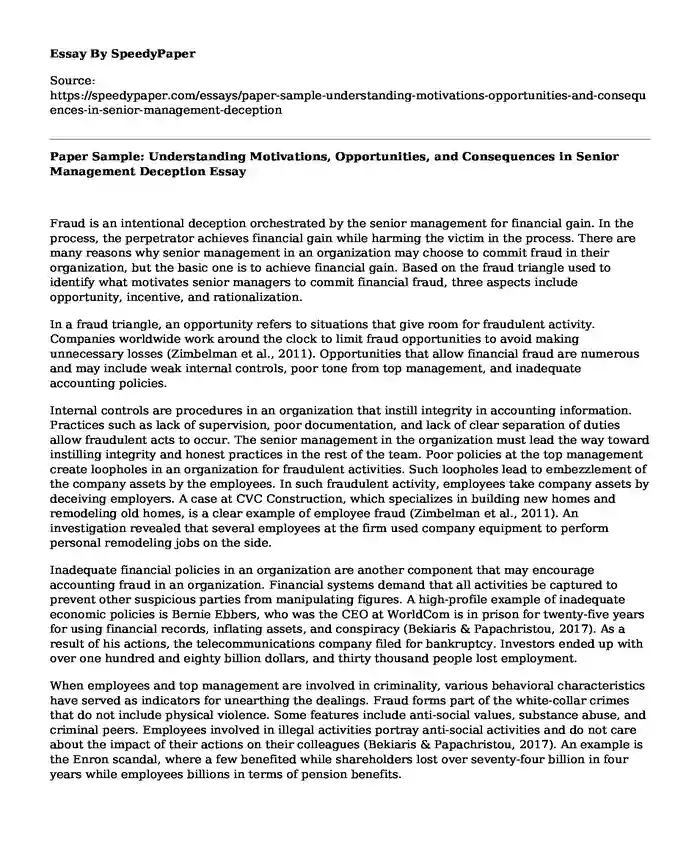
| Type of paper: | Essay |
| Categories: | Company Management Finance |
| Pages: | 3 |
| Wordcount: | 578 words |
Fraud is an intentional deception orchestrated by the senior management for financial gain. In the process, the perpetrator achieves financial gain while harming the victim in the process. There are many reasons why senior management in an organization may choose to commit fraud in their organization, but the basic one is to achieve financial gain. Based on the fraud triangle used to identify what motivates senior managers to commit financial fraud, three aspects include opportunity, incentive, and rationalization.
In a fraud triangle, an opportunity refers to situations that give room for fraudulent activity. Companies worldwide work around the clock to limit fraud opportunities to avoid making unnecessary losses (Zimbelman et al., 2011). Opportunities that allow financial fraud are numerous and may include weak internal controls, poor tone from top management, and inadequate accounting policies.
Internal controls are procedures in an organization that instill integrity in accounting information. Practices such as lack of supervision, poor documentation, and lack of clear separation of duties allow fraudulent acts to occur. The senior management in the organization must lead the way toward instilling integrity and honest practices in the rest of the team. Poor policies at the top management create loopholes in an organization for fraudulent activities. Such loopholes lead to embezzlement of the company assets by the employees. In such fraudulent activity, employees take company assets by deceiving employers. A case at CVC Construction, which specializes in building new homes and remodeling old homes, is a clear example of employee fraud (Zimbelman et al., 2011). An investigation revealed that several employees at the firm used company equipment to perform personal remodeling jobs on the side.
Inadequate financial policies in an organization are another component that may encourage accounting fraud in an organization. Financial systems demand that all activities be captured to prevent other suspicious parties from manipulating figures. A high-profile example of inadequate economic policies is Bernie Ebbers, who was the CEO at WorldCom is in prison for twenty-five years for using financial records, inflating assets, and conspiracy (Bekiaris & Papachristou, 2017). As a result of his actions, the telecommunications company filed for bankruptcy. Investors ended up with over one hundred and eighty billion dollars, and thirty thousand people lost employment.
When employees and top management are involved in criminality, various behavioral characteristics have served as indicators for unearthing the dealings. Fraud forms part of the white-collar crimes that do not include physical violence. Some features include anti-social values, substance abuse, and criminal peers. Employees involved in illegal activities portray anti-social activities and do not care about the impact of their actions on their colleagues (Bekiaris & Papachristou, 2017). An example is the Enron scandal, where a few benefited while shareholders lost over seventy-four billion in four years while employees billions in terms of pension benefits.
Conclusion
Fraud has distressing consequences for employees, shareholders, organizations, and the community in general. From past actions, it is clear that new mechanisms that allow copying keep popping up. Still, organizations must train and instill integrity among employees to prevent fraud. It is clear from numerous fraud cases around the world that top management plays a significant role. Therefore, organizations need to look into how organizations safeguard from losing large assets from a few individuals' actions.
References
Albrecht, W., Albrecht, C., Albrecht, C., & Zimbelman, M. (2011). Fraud Examination. South-Western, Cengage Learning.
Bekiaris, M., & Papachristou, G. (2017). Corporate and accounting fraud: Types, causes, and fraudster's business profile. Corporate Ownership & Control, 15(1-2), 467-475. http://doi.org/10.22495/cocv15i1c2p15
Cite this page
Paper Sample: Understanding Motivations, Opportunities, and Consequences in Senior Management Deception. (2023, Dec 11). Retrieved from https://speedypaper.net/essays/paper-sample-understanding-motivations-opportunities-and-consequences-in-senior-management-deception
Request Removal
If you are the original author of this essay and no longer wish to have it published on the SpeedyPaper website, please click below to request its removal:
- Free Essay Sample on Project Closure
- Free Essay on Nike Aquiring Lululemon
- Free Essay: The Role of CRM in Supply Chain Management
- Paper Example on Factors That Influence Foreign Exchange Rates
- Free Essay Example on Forex Trading
- Essay Example: Effects of Money Laundering on Our Economy
- Project Manager's Concerns in Developing a WBS with Software - Essay Sample
Popular categories




